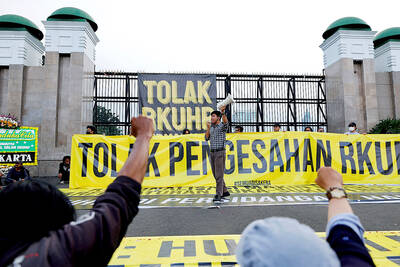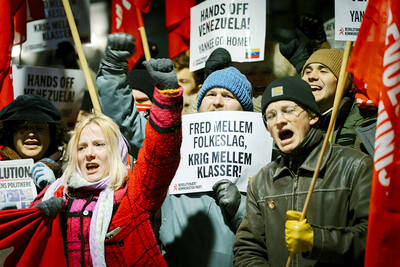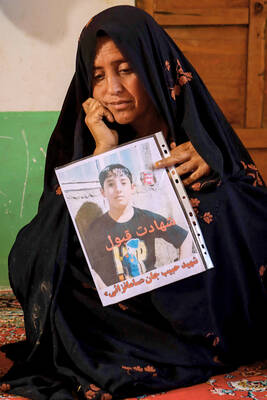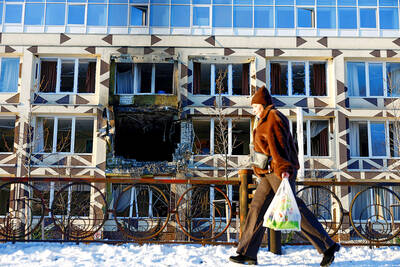If French agents who blew up the Rainbow Warrior in Auckland harbor 20 years ago were trying to sink the Greenpeace movement along with its protest ship, they couldn't have done a worse job.
Instead of scuttling the environmental group in what New Zealand considers its only terrorist attack, the French strike gave Greenpeace a rallying point and a sharper focus.
"It was the end of our youthful, exuberant innocence," Steve Sawyer, leader of the Rainbow Warrior's anti-nuclear protests 20 years ago, told reporters in an interview ahead of today's anniversary of the blast on July 10, 1985.

PHOTO: AP
"We suddenly became very, very deadly serious," he said, because "democratic governments were willing to kill us."
In the years since, the organization formed in 1971 has grown into an environmental powerhouse with 2.8 million supporters worldwide.
The blast, which killed a Greenpeace photographer, Dutchman Fernando Pereira, gave the group "an aura of credibility and respectability we hadn't had previously. We were in the center of some pretty big politics ... [with] a lot more access," Sawyer added.
mines planted
As Greenpeace commemorates the attack, the group remains angry over the French operation. Today, the sunken ship's replacement, Rainbow Warrior II, will visit New Zealand's Matauri Bay, where the original Rainbow Warrior was scuttled after being refloated during an investigation. Divers will lay a marble sculpture of a dove with an olive branch on the sea bed near the sunken vessel.
In July 1985, two mines planted by French secret service frogmen tore apart Rainbow Warrior's hull as the ship was readying to sail to France's South Pacific nuclear test site at Mururoa Atoll as part of a campaign for a "Nuclear Free Pacific."
The first device tore a hole big enough "to drive a Volkswagen through" said the vessel's skipper, Pete Willcox.
Willcox, then 32, was asleep in his bunk when the ship shuddered under the first blast and water gushed into its engine room. Pereira ran below to grab some of his camera gear while Willcox was checking whether people had escaped from their cabins. Then a second high-powered mine detonated "right under us ... on the propeller shaft," Willcox said, adding that the blast "trapped Fernando Pereira in his cabin and drowned him."
Police divers confirmed the blasts were sabotage. Within two days, the "finger was pointing at France ... but we didn't believe it at first," said Alan Galbraith, the retired detective who headed the investigation. The evidence became overwhelming: diving tanks with French markings; a French yacht which delivered the explosives and saboteurs; seized computer phone logs with direct dial numbers to the French secret service in Paris.
agents arrested
Two of nine French agents who entered New Zealand were arrested within days. Instead of fleeing the country, agents Alain Mafart and Dominique Prieur were waiting for a refund due for returning a rented van early.
"To our surprise they were still waiting for their check refund" when detectives tracking the vehicle walked into the rental office, said Maurice Whitham, one of the investigators.
Said Galbraith: "It wasn't the best spy technique -- receipts were kept. It was a significant paper trail" for detectives to follow.
New Zealand branded the attack "an act of state-sponsored terrorism" and after years of open hostility with France it won a multimillion dollar reparations payment and what Greenpeace has called an "unconvincing apology." Pierre Lacoste, who headed France's counter-espionage agency at the time, said in an interview last week with the New Zealand Herald that the drowning of photographer Pereira was an accident that weighed heavily on his conscience.
"I would perfectly understand it if New Zealanders considered this act to be an act of terrorism, to sink a boat in a port where there are just yachtsmen, peaceful people," he told the newspaper.
"It does not really deserve to be called that, but if it is felt in that way, that is reality," he said.
After the attack, Lacoste was fired and then-Defense Minister Charles Hernu resigned. The two arrested French agents, each sentenced to 10 years for manslaughter, were freed within two years after France threatened trade and other sanctions against New Zealand.
Willcox said the attack raised the hostility over French nuclear testing "to a much higher level than it ever would have been if they hadn't blown up the boat."
"I don't hold any anger toward the French people," he said. "I just hold anger toward members of their government who made these really stupid decisions."

Indonesia yesterday began enforcing its newly ratified penal code, replacing a Dutch-era criminal law that had governed the country for more than 80 years and marking a major shift in its legal landscape. Since proclaiming independence in 1945, the Southeast Asian country had continued to operate under a colonial framework widely criticized as outdated and misaligned with Indonesia’s social values. Efforts to revise the code stalled for decades as lawmakers debated how to balance human rights, religious norms and local traditions in the world’s most populous Muslim-majority nation. The 345-page Indonesian Penal Code, known as the KUHP, was passed in 2022. It

‘DISRESPECTFUL’: Katie Miller, the wife of Trump’s most influential adviser, drew ire by posting an image of Greenland in the colors of the US flag, captioning it ‘SOON’ US President Donald Trump on Sunday doubled down on his claim that Greenland should become part of the US, despite calls by the Danish prime minister to stop “threatening” the territory. Washington’s military intervention in Venezuela has reignited fears for Greenland, which Trump has repeatedly said he wants to annex, given its strategic location in the arctic. While aboard Air Force One en route to Washington, Trump reiterated the goal. “We need Greenland from the standpoint of national security, and Denmark is not going to be able to do it,” he said in response to a reporter’s question. “We’ll worry about Greenland in

PERILOUS JOURNEY: Over just a matter of days last month, about 1,600 Afghans who were at risk of perishing due to the cold weather were rescued in the mountains Habibullah set off from his home in western Afghanistan determined to find work in Iran, only for the 15-year-old to freeze to death while walking across the mountainous frontier. “He was forced to go, to bring food for the family,” his mother, Mah Jan, said at her mud home in Ghunjan village. “We have no food to eat, we have no clothes to wear. The house in which I live has no electricity, no water. I have no proper window, nothing to burn for heating,” she added, clutching a photograph of her son. Habibullah was one of at least 18 migrants who died

Russia early yesterday bombarded Ukraine, killing two people in the Kyiv region, authorities said on the eve of a diplomatic summit in France. A nationwide siren was issued just after midnight, while Ukraine’s military said air defenses were operating in several places. In the capital, a private medical facility caught fire as a result of the Russian strikes, killing one person and wounding three others, the State Emergency Service of Kyiv said. It released images of rescuers removing people on stretchers from a gutted building. Another pre-dawn attack on the neighboring city of Fastiv killed one man in his 70s, Kyiv Governor Mykola